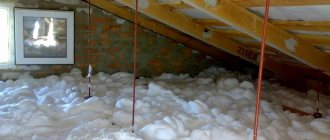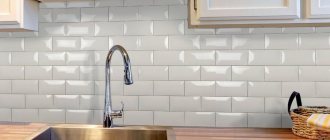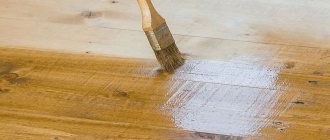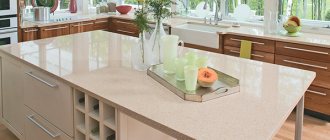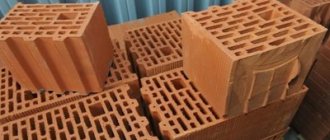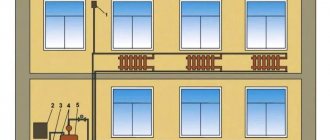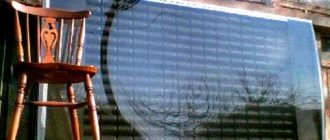12.04.2018 0
15571
Leveling tiles during installation is not an easy task, especially if it is done by a non-professional. To place tiles evenly and neatly on the floor or wall, you can use a special system. To do this, you should find out its characteristics, advantages and disadvantages, and also study reviews.
What is a tile leveling system (SVP)
SVP is a modern technology developed specifically for leveling tiles. Initially, SVP appeared abroad, and after a while they began to use it here. The system is used for laying not only tiles, but also porcelain stoneware, the thickness of which is 3-20 mm, on the floor and walls.
The SVP includes a clamp and a wedge. Reusable wedges can be used repeatedly, but the clamps remain inside the joint during tile laying. Similar foreign hovercrafts have separate tongs and generally have a more complicated design.
Where to buy SVP?
You can order original Karofit SVPs from the manufacturer on the website svptool.ru
SVP Karofit (Karofit TLS) is a complete analogue of RLS Raimondi and DLS, both in shape/size and quality. Production is located in Turkey.
- Karofit has a clip (clip/base) that is only 1mm thick!
- the shape of the wedges has also recently been refined and updated - now they have a sharper shape, and thanks to the directional teeth the wedges are clamped even smoother and softer
- the wedge is made of durable alloy - it is truly reusable (unlike some cheaper SVPs)
- at the moment SVP Karofit has the best price among its analogues
- the Karofit system is represented in many European countries - Germany, Spain, France, Belgium, the Netherlands, Austria, Serbia, Czech Republic, Poland, Bulgaria, Turkey, and now Russia
- Among the company's own developments are pliers (clamping tools), the quality of which has already been appreciated by hovercraft manufacturers in many countries and they have begun to equip their systems with them. Mustang LS (Spain), Pony LS (Spain), DLS (Russia), Lantelme (Germany), Tegelleveling (Netherlands) and many others use Karofit tongs in their svp
@instabur.pro recommends!
Buy SVP Karofit
Features of use
If the installation of the facing coating is carried out unprofessionally, it will ruin the interior and lead to a host of other unpleasant consequences - for example:
- Fungal formations and dirt will begin to appear in the seams between the tiles.
- There is a possibility of accidental injury.
- Under the influence of mechanical loads, the material will begin to collapse.
Most often, this leveling system is used if the tiles are larger than 40 cm. Sometimes it is used for small facing materials.
The following types of leveling structures are distinguished: with a wedge-shaped or screw tensioner, with a special tool for fixation - a jagged strip.
Designs with a wedge-shaped tensioner include two plastic elements - a wedge with a tooth and a key-clamp with a base in the shape of a polygon or oval. The clamp is a plastic element in the shape of the letter “T”. Its top part can be quickly broken off. This element can be used once, and the wedge can be used repeatedly. The design may contain tapes, meters, clips, caps and other auxiliary elements. It is necessary to purchase a rubber hammer to use it to beat off the locking mechanism.
To tighten the structure with a screw tensioner, a steel pin and a screwdriver are used.
Leveling systems with a locking tool are used for installing tiles whose thickness ranges from 3 to 30 mm. You also need to additionally purchase a special tool.
Variety of systems
This unique tile leveling system is available in two types. The first option is cheaper, so it is used much more often.
Typically, such an inexpensive system is used on uneven ground with differences in height . Here you will need a wedge that will clamp the base element of the system and position the tile evenly on the plane.
The price of another type of system, designed for smoothing ceramic cladding, is several times more expensive. This system stands out for its unusual structure - curved inserts. This is what allows you to achieve self-leveling without the use of additional intervention. The plates begin to align automatically, and this allows many defects to appear .
Advantages and disadvantages of the system
The advantages of the system are as follows:
- SVP ensures the stability of the cladding after the glue shrinks. Reliable fixation of the tiles prevents the installation from moving to the side.
- The system also ensures even tile gaps. But sometimes specialists use plastic crosses to adjust them.
- The cost of laying tiles increases, especially in cases where the installation is carried out by hand, without the appropriate knowledge, skills and abilities.
- SVP can be used repeatedly (except for consumable clamps).
However, such a system also has disadvantages - for example:
- The tiles cannot be washed on the day of installation, which primarily applies to the fastener area. After the glue has hardened, you can remove the wedges. Cleaning cured glue can take a lot of time.
- When installing the SVP, it is impossible to make seams less than 3 mm due to the thickness of the flow gates or rings.
- “One-time” items will need to be constantly purchased.
Advantages of the technique
When using special tools for laying tiles, the following advantages are achieved:
- formation of a perfectly flat floor with minimal effort;
- the formed coating looks more aesthetically pleasing and has a long service life;
- in the process of laying tiles using the system, identical seams are obtained over the entire area;
- the adhesive composition is evenly distributed over the surface of the base, leveling differences in height and filling all cracks and voids;
- after installing the tiles on the floor there will be no shrinkage, even under significant operating loads;
- As the glue dries, the tile does not move as a result of shrinkage, which avoids deformation of the coating.
A quick and high-quality way to lay tiles
Comparison of domestic and foreign analogues
SVP systems vary depending on the manufacturer. Leveling systems produced on the Russian market consist of a wedge and a clamp. The wedges are reusable, but the consumables-clamps are disposable, since part of them remains inside the seam after completion of the installation work.
Analogues from foreign manufacturers additionally include mechanisms for twisting, tightening or latches for fastening - Litolevel from Litokol, Rubi.
SVP models have different components that are supplied complete.
SVP (gate and ring)
System advantages:
- Strength, high reliability of wedges compared to caps. Wedges are useful when styling.
- Excellent fixation, no damage to the ties.
- No need to soak screeds, small bearing areas. After a few hours of break, it is not difficult to continue working - just make a small recess under the cap or install them immediately.
But there is also a drawback. To remove the ties, you need to kick them or use a mallet. However, if struck at an angle to the seam or in places where the glue is clogged, the screed will break in the wrong place.
Rubi
Advantages:
- High quality plastic, professionally designed design.
- Reliable design of the support platform. Thanks to the flexibility of the petals, strong fixation of tiles with a thickness of 3-20 mm is ensured.
- Nylon ties soaked in water for half an hour become more tensile. Once dry, they are quickly removed using pliers. They need to be soaked according to the manufacturer's instructions.
- The design of the tie loosening is also convenient; it breaks in the required place.
- The 0.8 mm screed ensures the thinness of the seams and the ability to adjust them using crosses.
Flaws:
- Less reliable fastening of the clamps; if glue gets in contact with them, they do not hold.
- Minimum clamping force. When you try to increase it, the risk of breaking the ties increases.
- After the break, the work becomes more difficult. If the ties are inserted immediately, they will dry out within a few hours, which increases the risk of them breaking. Since the area is large, it is difficult to insert them into the glue that has had time to dry. You will need to use a screwdriver or spatula.
- Although the caps can be reused, they can only be used a maximum of 7 times in a row.
In addition, such a system is expensive.
Tile cutter
This type of tool is considered the main component of the installation process. Thanks to this equipment, it is possible to create an ideal surface. The design of the mechanism allows you to accurately adjust the size of the ceramic decor in the corner area.
- The advantage of a tile cutter is its low cost and good performance.
- The guide tubes of high-quality options are made of stainless steel, due to which their surface is not formed.
- Budget tool models are made from low-grade raw materials.
- After just a few uses, the metal frame bends and the play of the cutting base is unable to make the correct size.
When choosing a tool, you need to rely on its cost. Professional tilers prefer to choose products whose price can reach up to 10,000 rubles.
Today in construction departments you can find models from Austria, Germany and Italy. According to the expert, the design of the tool from a foreign manufacturer will last a long time.
Products from China quickly become deformed with regular use. The cutting play is designed to process 900 sq.m. The advantage of such models is their ability to handle porcelain tiles.
Instructions for use
First of all, you need to make sure that the room temperature is approximately +10°C. This is the ideal temperature for hovercraft.
Next you need:
- Prepare the glue by diluting it according to the manufacturer's instructions.
- Apply the mixture to the floor or wall with a notched trowel.
- Lay the first tile on the floor.
- Make sure it is laid correctly using a building level.
- Install 2 clamps on all sides of the part, maintaining a 1-5 cm space from the edges.
- Place the second tile end to end.
- Insert a wedge between the outer part of the clamp and the tile so that it firmly adheres to both tiles to align them.
- Remove excess glue (once it dries, it will be difficult to remove).
- Cover the remaining surface.
After the glue has dried, the wedges must be removed. To do this, you need to hit them with a rubber hammer along the tile seams.
Notched trowel
A construction spatula with iron teeth is designed for uniform distribution of tile adhesive. Thanks to this tool, the ceramic decor will be firmly fixed on vertical and horizontal surfaces.
Construction departments offer several types of products. They differ in letter and number markings. For example, products with the letter A are designed to work with porcelain stoneware. Category B models have square teeth. They are chosen for working with small mosaics.
Consumption
There are 3 factors that affect material consumption:
- SVP quality. If it is low, then the tools will easily break during installation, and you will have to spend money on repairs.
- Professionalism of the master. If an inexperienced worker works with the SVP, there is a risk of making mistakes and omissions that will completely ruin the result.
- Sizes of tiles. If they are large, you will need to use auxiliary mechanisms for fixation.
To calculate the number of units, you must use the formula C=K/S, where:
- C – consumption;
- K – number of fixing elements for two tile coverings with a common border;
- S – area of one tile, in m2.
Construction tape and marker
Such tools are used to create markup. In addition, it is possible to accurately measure the distance between parts or prepare an element of the required size.
Professional tilers prefer to work with tape measure models, the rod of which is made of soft sheet metal.
Some versions of the tool have a laser level. Thus, when purchasing this tool, you can save on purchasing a guide level.
Price
The cost of tile leveling systems depends on the material from which it is made and also on the number of units in the package.
SVP produced have the following packaging options:
- Gate clamp 1.0 mm (USVP) - 101 pcs. at a price of 150 rub. per package
- Gate clamp 1.0 mm (USVP) - 501 pcs. at a price of 705 rub. per package
- Clamp Ring 1.4 mm (USVP) - 101 pcs. at a price of 150 rub. per package
- Clamp Ring 1.4 mm (USVP) - 501 pcs. at a price of 705 rub. per package
- Wedge Gate 1.0 mm (USVP) - 201 pcs. at a price of 525 rub. per package
- Wedge Gate 1.0 mm (USVP) - 51 pcs. at a price of 140 rubles. per package
- Wedge Ring 1.4 mm (USVP) - 201 pcs. at a price of 525 rub. per package
- Wedge Ring 1.4 mm (USVP) - 51 pcs. at a price of 140 rub. per package
Our 5 favorite systems of 2021 (SVP):
| model | Price | Weight | Editor's Rating |
| DLS | Check price | 5 pounds | 4.8 / 5 |
| KAROFIT | Check price | 4 pounds | 4.6 / 5 |
| 3D KRESTIKI | Check price | 3 pounds | 4.4 / 5 |
| TLS | Check price | 1 pound | 4.2 / 5 |
| FARTON | Check price | 1 pound | 3.9 / 5 |
Homemade option
You can make a hovercraft yourself: in this case, the design of the system will be simple, but at the same time, economical.
You will need to purchase the following tools:
- Aluminum wire for clamping with a thickness of 1.7 mm.
- Small pieces of hardboard (fibreboard) used as wedges.
- Cut mounting tape plates to provide support.
The aluminum wire is bent to achieve an elongated rectangular shape. A plate is being installed to provide support. The lower parts of the wire (they will be placed below the plane of the tile) should be “bitten” on both sides. This will allow you to break it off faster later.
After installing the device between the tiles, it is necessary to twist the upper ends of the wire into a spiral. Before this, pieces of hardboard are installed under the wire to fix the materials. Once the glue is completely dry, the clamps are removed. You also need to cut off the protruding parts of the loop with wire cutters.
Installation of tiles will be accelerated and simplified even when using a self-made mechanism, which is inferior in functionality to professional models.
Tool for removing old tiles
This type of tool is intended for preparatory work. The metal rod at the bottom has a flattened base that allows you to remove old tiles.
In addition, the tool can be used to dismantle wall structures and floor coverings.
The speed of work depends on the length of the tool handle. Products with a short lever are recommended to be used for mosaic coverings. To prevent the chisel from slipping out of your hand during use, it is recommended to purchase models with a rubberized handle.
Useful tips
- With the help of SVP it will not be possible to eliminate every surface unevenness. Alignment is carried out on the tile located at a higher level. Empty spaces are formed under the raised tiles. This risks causing the tiles to split and crack in the future. It is necessary to carry out the cladding, first ensuring a completely level base. It is permissible to use SVP on those surfaces where the maximum level of difference does not exceed 1 cm.
- Also, using SVP it is impossible to completely avoid cracks in the tiles. Its installation must be carried out using tile adhesive with a composition that is optimal for a particular coating. If the adhesive is not suitable for the tiles, then dynamic loads risk deforming the entire structure.
- The suitable temperature for using SVP is +10°C. You also need to take into account drafts and air humidity levels. This will ensure high quality work.
- When purchasing an alignment design, you should make sure of the quality of the mechanisms supplied in the kit. Today there are many fakes of such systems on the market.
- The quality of the tile materials should be maximum - this will ensure an even coating of the cladding.
- You should not try to save on the number of installed clamps, otherwise there is a risk of weak fixation of the structure, which will deform the coating.
Before using the SVP, you need to test your skills and abilities. To do this, it is enough to connect 9 tiles into a square on the floor using a hovercraft, without using an adhesive. This reduces the risk of damaging the tiles and SVP tools during installation.
What are the “disadvantages” of using leveling systems?
- 1. Sensitive additional costs when finishing small- and medium-format tiles in large volumes. For the customer, the costs of the SVP are evidence of the low qualifications of the contractor. 2. It is not effective for correcting uneven bases by laying tiles, and when tiling with a “propeller” it is even harmful. 3. When tightening a recessed sheet with a clamp, cavities may form under the coating. 4. After laying the tiles, it will not be possible to completely clean the seams from the glue, and scraping the hardened mortar after removing the clips is more difficult and time-consuming.
By and large, professional tilers do not need to use SVP. The time saved on leveling the sheets will then be spent on cleaning the seams from glue; ceramics with geometric defects must be laid without clamps, and with smooth tiles and a prepared base, the use of DLS will only slow down the work of the pros.
Types of devices for installing tile coverings
Devices for installing tile coverings can be standard (economy option) or advanced. The first option is used for surfaces where there is no significant difference in height.
In this case, the base element has a flat surface and is fixed in the right place using wedges for laying tiles. The result is high-quality cladding with identical seams.
When purchasing premium devices, you will notice that the seam tab has a concave structure. This feature helps to carry out high-quality installation of the cladding in any conditions, regardless of the condition of the base.
Today on the building materials market you can find Rubi and SVP (domestic manufacturer) products.
RUBI tile laying system
They work on the same principle, but have different structures. The domestic version is cheaper, but the quality is no worse than the imported counterpart.
